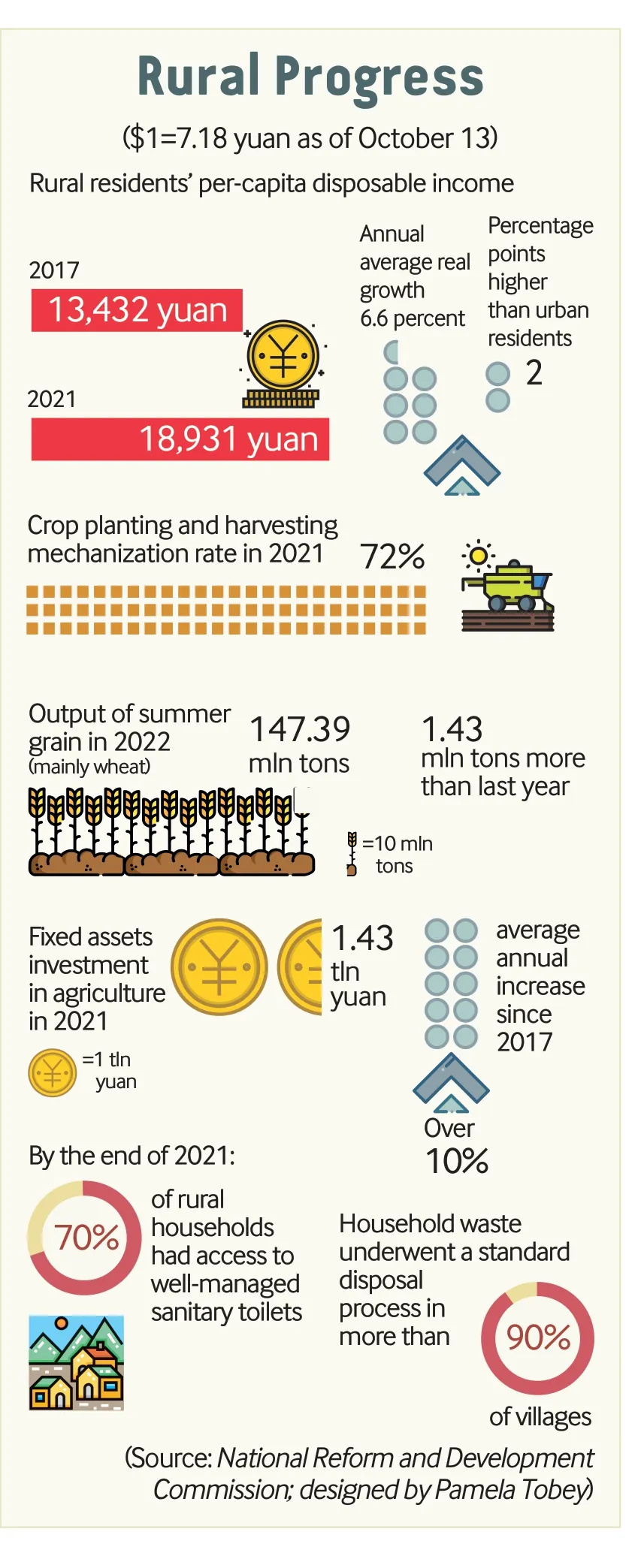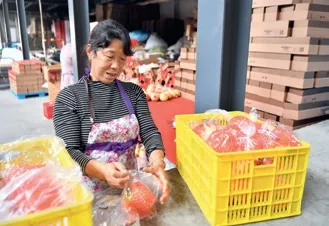Progress in the Pastures
2022-10-24TransformationoffarmingareasaimstobridgegapswithcitiesByJiJing
Transformation of farming areas aims to bridge gaps with cities By Ji Jing

Lujiawan Village in Huzhou, Zhejiang Province, on September 20
Rural revitalization has been a priority of China in recent years,especially since the country’s eradication of absolute poverty in 2020.
The national strategy of rural revitalization was announced in 2017 at the 19th National Congress of the Communist Party of China (CPC). Since then, it has provided guidance for the work of government departments, social agencies and businesses in rural areas, and agricultural workers in the new era. In June 2018, the CPC Central Committee and the State Council issued the Rural Revitalization Strategic Plan (2018-22),which laid out the goals and tasks during the period. The plan set objectives for building rural areas with thriving businesses, pleasant living environments,civility, effective governance and prosperity.
Since the strategy was implemented, rural areas have made remarkable progress in many aspects.
Boosted rural development
Ensuring food security has always been the top priority in the implementation of the plan. “In the face of the COVID-19 pandemic and the serious impact of the Ukraine crisis on the global grain supply chain, we have adhered to the policy of ensuring grain self-sufficiency and responded to the uncertainties overseas by providing stable domestic grain supplies,” Wu Xiao, Director of the Department of Rural Economy at the National Development and Reform Commission, said at a press conference on September 28.
China has consolidated and improved its grain production capacity by implementing a food crop production strategy based on improved farmland management and the application of advanced technologies.
Science and technology have played an increasing role in agricultural production.In 2021, 61 percent of growth in agriculture resulted from scientific and technological progress, and the rate of mechanization of crop planting and harvesting rose above 72 percent, covering all main crop varieties,Wu added.
The country has established a minimum threshold of 120 million hectares of arable land and is increasing the quality of farmland in order to produce high and stable yields on a large scale, regardless of drought or flood. It has also strengthened the protection and sustainable use of northeast China’s black soil farmlands, historically among the nation’s most productive.
China has also placed great emphasis on improved seeds. It prioritizes the development of its domestic seed industry by driving and supporting research on core seed source technologies and improved genetics. More than 95 percent of the nation’s cropland is now planted with domestically developed crop varieties, a major advance toward the achievement of food security and self-sufficiency goals.
China has also stepped up the introduction and implementation of policies that support grain production. The minimum purchasing prices for rice and wheat have been raised and subsidies for corn, soybeans and rice producers stabilized to ensure growers’incomes. China has set minimum purchasing prices for grain, including wheat and rice,since 2004. Under the scheme, the government buys grain from farmers at the state-set price when the market price drops below it.
In the past two years, the Ministry of Finance has provided 60 billion yuan ($8.4 billion) in agricultural material subsidies for crop farmers to mitigate the impact of rising agricultural material prices.
China has improved the regulation of the domestic grain market to increase the stability of supply, and also optimized the volumes of crop varieties in central and local grain reserves. China has improved the processing,transportation and sales network of refined grain and edible oil products and improved its ability to supply grain in emergencies. It has also beefed up efforts to reduce grain loss and waste during production and food waste by consumers.
Thriving industries are also essential to rural revitalization.Over the past five years, rural industries have developed rapidly. Development of agricultural product processing and distribution has accelerated. In 2021, 70.6 percent of the nation’s agricultural products had received some form of processing before they reached consumers. And the ratio of China’s agricultural processing output value to total agricultural output value has risen to 250 percent.
The development of agricultural, cultural and tourism industries has been integrated in rural areas. There are now more than 300,000 leisureagriculture market entities, such as sightseeing agriculture parks, with a combined annual revenue of more than 700 billion yuan ($97.4 billion).
Rural e-commerce is booming. There are more than 30,000 agriculture-related e-commerce entities, which registered a total sales volume of more than 2 trillion yuan ($278.6 billion)in 2021. New business models,such as selling agricultural products through live-streaming, are emerging.
Development of distinctive rural industries has accelerated.A total of 3,673 national demonstration villages and towns for specialty products, 2,438 products,and 662 rural craftsmen have been designated and given more importance, to spur the development of related industries.
Prosperity is one of the goals of rural revitalization. Wu said the Chinese Government has worked to expand channels for farmers to increase their incomes and improve their production and living conditions.

Long-term programs for increasing farmers’ incomes have been established to narrow the income gap between urban and rural residents. Training of migrant workers has been strengthened and the employment service system improved to expand rural people’s employment opportunities and increase their wages. In 2021, wage income exceeded 42 percent of rural people’s incomes and became the primary channel for income increase.
Rural infrastructure has been improved.The total length of rural roads has reached 4.46 million km. The rural power grid has been upgraded ahead of schedule and power supply has become more reliable. Over 94 percent of villages now have cable television.
Public services in rural areas have improved. The coverage rate of affordable kindergartens in rural areas reached 90.6 percent and the proportion of full-time teachers in rural compulsory education schools(grades 1-9) with a bachelor’s degree or above reached 72.23 percent. The coverage rate of comprehensive rural social service facilities has increased by more than 40 percentage points from 2017. More than 90 percent of towns and townships have hospitals and each village has at least one clinic on average. There are more than 17,000 rural nursing homes and more than 130,000 community-based senior care service facilities in rural areas.
Urban-rural integration
Establishing and improving urban-rural integrated development systems and policies are crucial for the implementation of the rural revitalization strategy.
A program of people-centered new urbanization has been implemented. The requirements rural migrant workers need to meet in order to apply for urban household registration status have been continuously lowered since 2017, and a large number of them and their family members have now been granted the status. Basic public services in urban areas have been expanded to cover migrant workers. Programs and channels for urban residents to pursue a career in rural areas have also been established and it has now become a new trend for migrant workers to return to their hometowns to start businesses.
Financial support for rural areas has been strengthened. Outstanding loans to the agricultural sector and to rural areas stood at 47.1 trillion yuan ($6.5 trillion) by late June this year, up 52.2 percent from the end of 2017.

An employee packages pomegranates at a rural cooperative in Lintong District, on the outskirts of Xi’an, Shaanxi Province, on September 26

A sporting activity in Chengdu, Sichuan Province, on September 23 celebrates the Chinese Farmers’ Harvest Festival
The integration of urban and rural infrastructure has been progressing well and provides urban and rural residents with equal access to basic public services. Integrated collection and treatment of waste water and garbage for urban and rural areas have been promoted. Urban and rural public transportation and logistics have also become more connected. As of the end of last year, express delivery networks covered 98 percent of towns and townships and all villages had access to broadband services. A unified basic old-age insurance system and basic medical insurance system for urban and rural residents have been established.
With these improvements, rural life has become better and the prospects for the rural areas brighter. BR
